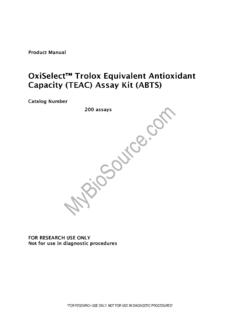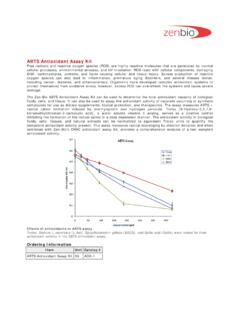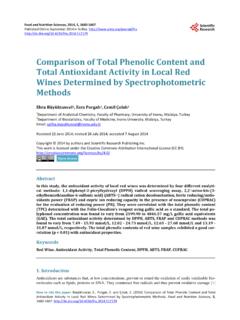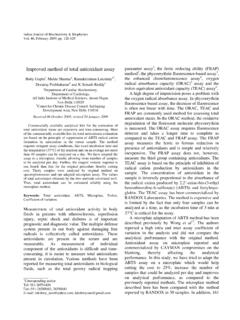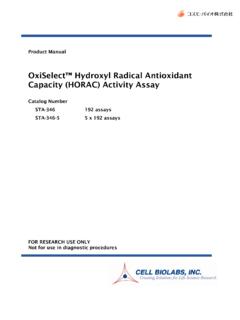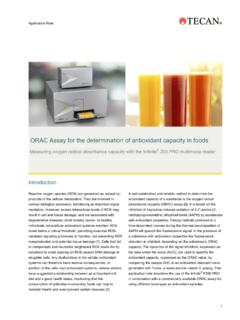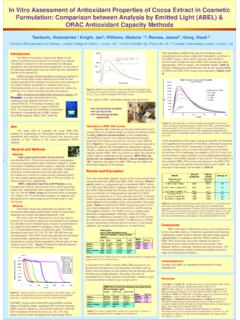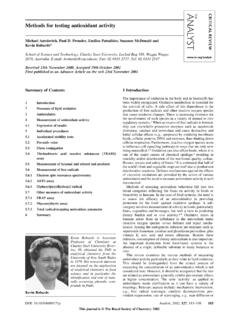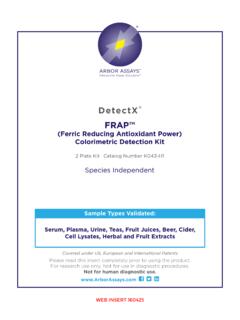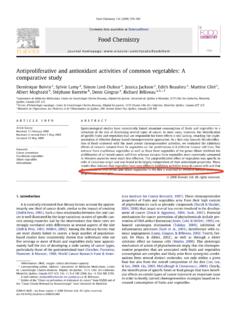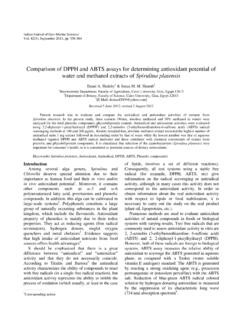Transcription of OxiSelect™ Ferric Reducing Antioxidant Power (FRAP) Assay ...
1
2 Product Manual Catalog Number -FOR RESEARCH USE ONLY. NOT FOR USE IN DIAGNOSTIC Oxidative stress is a physiological condition where there is an imbalance between concentrations of reactive oxygen species (ROS) and antioxidants .
3 However, excessive ROS accumulation will lead to inflammation and cellular injury, such as damage to DNA, proteins, and lipid membranes. The cellular damage caused by ROS has been implicated in the development of many disease states, such as cancer, diabetes, cardiovascular disease, atherosclerosis, and neurodegenerative diseases. Under normal physiological conditions, cellular ROS generation is counterbalanced by the action of cellular Antioxidant enzymes, macro or micro molecules, as well as other redox molecules. antioxidants are molecules that contain one or more free electrons that can be donated to stabilize ROS. antioxidants include both hydrophilic and lipophilic molecules for metabolizing ROS. These may be localized transiently within different tissues or cells.
4 Because of their potential harmful effects, excessive ROS must be promptly neutralized and eliminated from the cells by this variety of Antioxidant defense mechanisms. Introduction oxiselect Ferric Reducing Antioxidant Power (FRAP) Assay Kit is a quantitative Assay for measuring the Antioxidant potential within various samples such as serum, plasma, urine, saliva, tears, tissue homogenates, cell extracts, and purified food or drug extracts. The Assay is based on the highly-cited work of Benzie and Strain (ref. 1 and 2) in which iron reacts with a colorimetric probe to produce a blue product. The reaction is driven by the electron donating Reducing Power of antioxidants . The kit employs a ferrous iron standard which allows the user to determine the Antioxidant content present within their sample.
5 Each kit provides sufficient reagents to perform up to 200 assays, including standard curve and unknown samples. The FRAP Assay offers a simple and efficient analytical method for assessing age, disease, diet, or other physiological changes to Antioxidant status. The oxiselect Ferric Reducing Antioxidant Power (FRAP) Assay Kit is a quantitative Assay for measuring the Antioxidant potential within a sample. Ferric iron (Fe3+) is initially reduced by electron-donating antioxidants present within the sample to its ferrous form (Fe2+). The iron-colorimetric probe complex develops a dark blue color product upon reduction which can be measured at 540-600 nm (see Figure 1). Samples can be compared to the iron standard for deter mining Antioxidant potential.
6 This Assay is analytically sensitive to approximately 4 M of Fe2+ iron equivalents, or a FRAP value of 2. Assay Principle -FOR RESEARCH USE ONLY. NOT FOR USE IN DIAGNOSTIC Figure 1. Assay Principle. 1. oxiselect Total Glutathione Assay Kit Related Products 2. oxiselect TBARS Assay Kit (MDA Quantitation) 3. oxiselect Superoxide Dismutase Activity Assay 4. oxiselect Catalase Activity Assay Kit 5. oxiselect Intracellular ROS Assay Kit (Green Fluorescence) 6. oxiselect ORAC Activity Assay 7. oxiselect In Vitr o ROS/RNS Assay Kit (Green Fluorescence) 8. oxiselect Total Antioxidant Capacity (TAC) Assay Kit 9. oxiselect In Vitro Nitric Oxide (Nitrite / Nitrate) Assay kit 10. oxiselect Myeloperoxidase Activity Assay Kit (Colorimetric) 11.
7 oxiselect Glutathione Reductase Assay Kit 12. oxiselect Ascorbic Acid Assay Kit (FRASC) (Colorimetric) 1. Kit Components Colorimetric Probe2. (Part No. 286001): Two 1 mL tubes Iron Chloride Solution3. (P art No. 286002): Two 1 mL tubes Iron (II) Standard4. (Part No. 285901): One 500 mg amber tube of crystals Assay Buffer (5X) (Part No. 286004): Two 25 mL bottles -FOR RESEARCH USE ONLY. NOT FOR USE IN DIAGNOSTIC 1. 96-well microtiter plates Materials Not Supplied 2. 10 kDa MWCO centrifugal filter (for high protein content samples) 3. Ethanol or other organic solvent for lipid-based samples 4. 10 L to 1000 L adjustable single channel micropipettes with disposable tips 5. 50 L to 300 L adjustable multichannel micropipette with disposable tips 6.
8 Conical tubes, microcentrifuge tubes, and bottles for sample and buffer preparation 7. Centrifuge and/or microfuge 8. Sonicator or tissue homogenizer 9. Multichannel micropipette reservoirs 10. Microplate reader capable of reading absorbance between 540-600 nm Upon receipt, store the kit components at 4 C. Storage 1X Assay Buffer: Prepare 1X Assay Buffer by adding deionized water to the 5X Assay Buffer ( a dd 3 m L o f 5X A ssay B uffer t o 12 mL of d eionized water). Mix t horoughly unt il homogeneous. Use this buffer for preparing kit reagents and within the Assay . Store at 4 C when not in use. Preparation of Reagents Reaction Reagent: P repare t he Reaction R eagent j ust be fore us e a nd pr epare onl y e nough f or immediate applications.
9 Dilute the Colorimetric Probe 1:10 and the Iron Chloride Solution 1:10 in 1X Assay Buffer ( For 50 a ssays, add 500 L Colorimetric Probe and 500 L Iron Chloride Solution to 4 mL 1X Assay Buffer for 5 mL total). Vortex thoroughly. These preparation protocols are intended as a guide for preparing unknown samples. The user may need t o a djust the sample treatment accordingly. All s amples s hould be a ssayed immediately or store d for up t o 2 m onths at -80 C. A trial as say w ith a r epresentative t est s ample should be performed to determine the sample compatibility with the dynamic range of the standard curve. High levels of interfering substances may cause variations in results. Samples may be diluted in 1X Assay Buff er as necessary before testing.
10 Run proper controls as necessary. Always run a standard curve with samples. Preparation of Samples Serum*: Collect blood in a tube with no anticoagulant. Allow the blood to clot at room temperature for 30 minutes. Centrifuge at 2500 x g for 20 minutes. Remove the yellow serum supernatant without disturbing the white buffy layer. Samples should be tested immediately or frozen at -80 C. Plasma*: Collect blood sample and add to a blood collection tube containing heparin as the anticoagulant. Centrifuge at 3,000 rpm for 10-15 minutes at 4 C. Remove the upper yellow plasma supernatant layer without disturbing the white buffy coat (leukocytes). Samples should be tested immediately or frozen at -80 C. -FOR RESEARCH USE ONLY.
